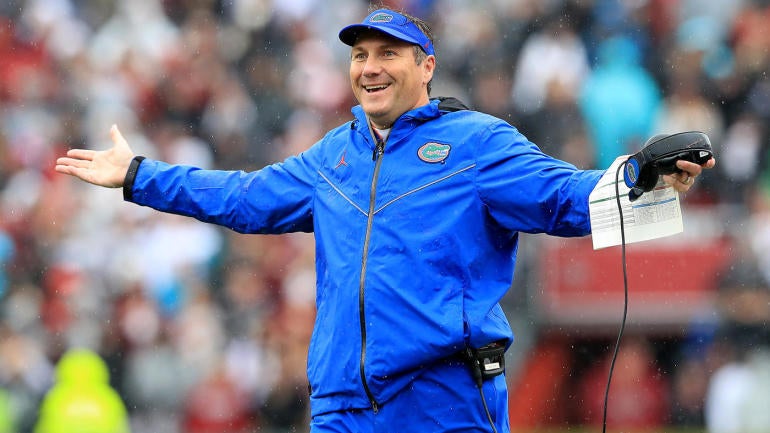College Football Playoff 12-team expansion: SEC, Group of Five among winners; Rose Bowl tops losers
Plus, Notre Dame has plenty to celebrate and question about this potential move

From here on, no one can accuse the College Football Playoff of driving in the slow lane. In recommending an expansion of the four-team bracket to 12 teams on Thursday, a CFP working group favored tripling the playoff field less than two months after saying it was merely considering such a move.
Seven years into a 12-year contract with that was supposed to relieve the pressure on the system, the bracket is already growing.
Where do we go from here?
The CFP Management Committee will discuss the matter at its regularly-scheduled meeting June 17-18. From there, a formal recommendation is expected to be made to the CFP Board of Managers. Based on the events of Thursday, that should be a rubber stamp (more on the process here).
We've been told an expanded bracket won't hit until the 2023 season at the earliest. It would actually be tremendously complicated to reconfigure the current CFP contract with ESPN before it expires after the 2025 season.
But here we stand. Championship representation goes from 3% (four out of 130) to 9%. Perhaps not ideal in that almost one-fifth of 125 teams in the FCS make its playoffs (24), but it's a start -- and it's better.
As far as who is affected the most by this proposed CFP expansion, let's take a look.
Winners
Group of Five: AAC commissioner Mike Aresco, who has lobbied so long and hard for his conference's inclusion, was headed out to dinner Thursday night with his wife. He was asked facetiously if he was on his second bottle of champagne. "I may drink it straight out of the bottle," Aresco said.
It's time to celebrate for the Group of Five conferences. The AAC, Conference USA, MAC, Mountain West and Sun Belt got what they always desired: a seat the table. Maybe more than one as the recommendation calls for the six highest-ranked conference champions (not specified to include the Power Five) plus six at-large teams in the field. That's another way of saying, for the first time, the Group of Five will be guaranteed at least one opportunity to play for the national championship.
In fact, Group of Five could get multiple berths. That would have happened last year when No. 8 Cincinnati and No. 12 Coastal Carolina would have gotten into the field as conference champions ahead of No. 25 Oregon.
The commissioners had to know what they were doing. That possibility makes the model a slam dunk when the presidents consider it. The access "problem" that has existed for almost a quarter century in the BCS and CFP has been addressed. Major-college football has never done Cinderellas well. Can't wait to see who fits the glass slipper first.
SEC: More chances for the Strength Everywhere Conference to increase its stranglehold on the sport. In an eight-team field, the SEC would likely have seen at least two teams each year. In a 12-team bracket, the possibilities are almost limitless. Adding up the berths over the last two seasons, the SEC would have seven of the 24 spots – 3.5 per year.
Coffers: They'll be full -- or fuller at FBS schools. Industry sources have estimated an expanded bracket to be worth two or three times more than the current $600 million annually. The question is whether ESPN is willing the tear up the current deal with five years to go on it and renegotiate for a 12-team field.
On the plus side, ESPN has exclusive negotiating rights at the moment. In five years, it could be rolling the dice with other networks streaming services in the mix bidding up the price. As mentioned, CFP executive director Bill Hancock said an expanded bracket won't debut until at least 2023.
Campuses in December: They can be some of the dreariest places in academia. Everybody is either taking finals or home for the holidays. Now try to picture first-round playoff games in the snow at Camp Randall Stadium or walking down High Street packed to the gills in Columbus, Ohio, in second week of December.
For athletic directors and businesses, it's going to be found money. Ticket revenue they never budgeted. Hotels that suddenly fill up. Here's hoping Arizona State shoots up the charts. We'd love to have a first round game in Tempe during Christmas season.
Jerry Palm (and bracketologists everywhere): This makes their job more fun and more complicated. It increases a conversation that, at times, dies down late in the season when it becomes clear that certain teams will lock up spots. The field would create more intrigue as we see when projecting the NCAA Tournament. For grins, here is what the bracket would have looked like in 2019, the last full season to be played.
No. 12 Memphis at No. 5 Georgia (winner vs. No. 4 Oklahoma)
No. 11 Utah at No. 6 Oregon (winner vs. No. 3 Clemson)
No. 10 Penn State at No. 7 Baylor (winner vs. No. 2 Ohio State)
No. 9 Florida at No. 8 Wisconsin (winner vs. No. 1 LSU)
Conference championship games: They now become as close to first-round playoff games as can be. Automatic spots go to the top six conference champions with four of those getting first-round byes. The field is now big enough to absorb the losers of those games should there by monster upsets. Think of 8-4 Northwestern upsetting 11-1 Ohio State in 2018. It didn't happen, but if it did, the Wildcats likely would have gotten one of those six bids. The Buckeyes would have been relegated to an at-large spot in the bottom six. Big picture: The sanctity of a conference championship will be enhanced.
Pac-12: A larger bracket, a better chance for the low-flying Pac-12 to participate. That's something that's been lacking on the Left Coast, which has missed five of the first seven playoffs. Some of the first words out of incoming commissioner George Kliavkoff's mouth advocated for an expanded playoff. He got his wish, even if it means the playoff has to expand to include the Pac-12 instead of the Pac-12's improvement getting it into the top four.
But it's not guaranteed. Again, if you built out the 2020 bracket to 12, conference champion Oregon would have missed the field in lieu of Cincinnati and Coastal Carolina.
"The autonomy five conferences deserve an opportunity to compete in the CFP every year," outgoing commissioner Larry Scott said. On his way out the door, he will get his wish.
Losers
Rose Bowl: The Granddaddy of Them All had to be brought kicking and screaming into the BCS era that transitioned into the CFP. The Rose had to basically give up its traditional Big Ten-Pac-12 matchup in years when the BCS/CFP was played in Pasadena, California. That was 23 years ago when the BCS was formed.
In a 12-team field with the quarterfinals being played on or around Jan. 1, the Rose is almost certain to lose more of that tradition. Think of a Rose Bowl quarterfinal hosting Notre Dame and Coastal Carolina. That could have happened last season if the expanded bracket was in place. (As mentioned, Pac-12 champion Oregon wouldn't have made the field.)
It also takes the bowl itself out of contention to host a semifinal unless the Rose backs off its long-held refusal to move its date. The semifinals will be held later in January. The Rose already lost its ability to hold a national championship with the beginning of the CFP in 2014.
Sources are already indicating the Rose will be forced to give up its exclusivity because of the increased bracket size. Sorry, Rose, but it's unlikely the Jan. 1, 2 p.m. PT time slot may not be guaranteed, either. (Along the sun setting over the San Gabriel Mountains.) And if it's part of a rotation of bowls, it's entirely likely the Rose could get third choices from the Pac-12 and/or Big Ten in years it does not host a CFP game. The Granddaddy has never looked so fragile.
Notre Dame: Like basically everyone, Notre Dame has a better chance at the playoff. So it's definitely not all bad for the Fighting Irish. However, because they operate as an independent, they can never finish in the top four (guaranteed to conference champions) and avoid the play-in game. That means, each and every year Notre Dame qualifies, it must win four straight games (16 total) to become national champions. And you thought the Fighting Irish had problems lately in the CFP (outscored 61-17 in their last two appearances)?
Will this caveat be enough to push Notre Dame into the ACC? Its media rights contract is structured so that, if it decides to join a conference at any point before 2036, it must be the ACC.
While Notre Dame has more access in a 12-team field, its road to a national championship just got a lot tougher. Even though athletic director Jack Swarbrick admits the Irish playing that additional game is more fair due to it not being forced to play in and win a conference championship game, it still puts his program at a disadvantage if it is otherwise deserving enough to be ranked in the top four.
"I look forward to never hearing again that we played one less game or never played a conference championship," said Swarbrick, whose program plays only 12 regular-season games before going to the postseason.
The bowl experience: The bowl system was already on shaky ground after COVID-19 forced several bowls to cancel last season. Now the CFP is going to take eight teams that would have been playing in bowls outside of the playoff. Will this force some bowls to shutter for good? The pecking order will drop a notch for several high-level bowls. Bowls that got the No. 2 team from a conference will suddenly get No. 3 or No. 4. There was already speculation that 42 bowls was too many. And if you thought opt outs were a problem before, they will be more of an issue.
The bowl experience will suffer, too. Sources indicate that, in a new 12-team playoff, teams will arrive in town a couple of days before the game. No trips to Disneyland, no playing on the beach, no steak feeds. Strictly a business trip. Think of a one-night stay to Tuscaloosa, Alabama. In and out. Your season is over. Sad.
Player safety: Something will have to be worked out with teams potentially playing 16 or even 17 games. That's basically an NFL schedule for one-third of the field played by college athletes. The optics are already bad with Congress breathing down the neck of major college sports.
Yes, yes, the FCS has a 24-team playoff, but the quality of athlete, the pressures on future NFL careers, the health concerns are just enhanced in the FBS.
At first glance, the liability is huge. More games, more chance for injury. More chance for injury, more chance for catastrophic injury. By expanding the field, the CFP managers seem to be playing with fire.
When asked Thursday about safety, Swarbrick -- the working group chair -- said it's not probable any of the conference champions seeded Nos. 5-12 in the first round would win out (and play 17 total games). That speaks more to access than excellence.
What's likely: The CFP will either start or pay into some sort of medical assistance fund that aids college athletes.


















